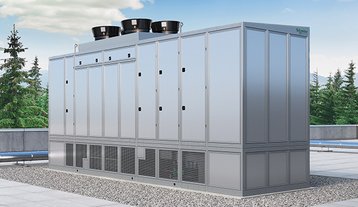As one of the major consumers of power in a data center, the cooling function is under constant scrutiny for ways in which its operation can be made more efficient.
Operators are on a quest to maximize the amount of time that can be spent in economizer mode, where the most power-hungry components of the cooling plant—compressors and chillers—can temporarily be turned off, providing that the surrounding ambient air temperature is low enough to deliver the required cooling. With traditional chilled water systems, however, this mode of operation generally occurs for a minority of the time throughout the year.
Given a number of trends over the last few years, in terms of IT equipment that can operate at higher temperatures, improvements in the efficiency of air-to-air heat exchangers and the software solutions that manage the overall cooling plant, it is now more feasible to design a data center with an integrated cooling system that can operate for a significant percentage of the year in economizer mode.
Maximize the economizer
Indirect-air economizers differ from the simpler direct-air economizer methods by isolating the cool outside air from the air in the data center through the use of a heat exchanger. As such, it protects against contamination from outdoor pollutants and against rapid fluctuations in temperature and humidity – conditions that can lead to downtime or shortened IT equipment life.
An effective, controllable indirect air cooling system has three main modes of operation. First, in air-to-air economization mode, cool outdoor air is passed through a heat exchanger, removing hot air from the IT space. It’s important to highlight that the two air streams never meet;
Secondly, air-to-air economization with the addition of evaporative cooling, where water is sprayed over the heat exchanger to lower the surface temperature of the heat exchanger if the outdoor airstream is not sufficiently cold in itself to do so; and thirdly, a DX cooling mode, to supplement the economizer modes, for when the air is too hot or humid to support the IT inlet set points.
For a typical data center in a moderate climate, maintaining an IT inlet temperature of 21.1C with the traditional chilled water cooling system with a plate and frame heat exchanger requires the outdoor air temperature to be 6.5C or lower in economizer mode.
The air-to-air heat exchanger, on the other hand, could maintain the same IT inlet temperature on full economizer mode when the outdoor air temperature is 15.2C. This means the systems economizer mode could be maintained for longer periods of time throughout the year, across a wider range of external air temperatures.
Utilizing a pre-tested, modular approach also provides additional benefits to data center operations. For example, the system can be placed outside the building itself or on the roof, freeing up space for more revenue-generating IT capacity and enabling both installation and maintenance to be carried out with minimal disruption to the IT equipment. A modular system also allows the cooling to scale up to match IT load, without requiring an up-front investment.
Standardization of software controls on modular cooling systems also helps to improve speed of deployment and efficiency. Control settings for traditional designs are typically engineered on-site and tend to be inflexible to changes, requiring system downtime if reprogramming is necessary. Pre-engineered control functions on prefabricated cooling systems can be reprogrammed easily to optimize the system’s operation, as the cooling requirements change over time.
Modular cooling systems using indirect air-to-air heat exchangers in conjunction with support from evaporative coolers, enable users to operate in economizer mode for more than 50% of the time in most climates, minimizing the amount of time that power-hungry components such as compressors and water chillers must be in operation. As such, they greatly assist in the achievement of reduced PUE, energy expenditure and greater overall cooling plant efficiency.
Direct comparisons of energy savings from self-contained indirect-air economizer cooling systems compared with traditional chilled-water economizer systems will depend on several factors, including load, geography and age of facility.


